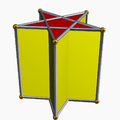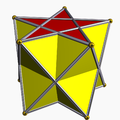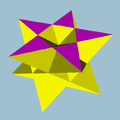Pentagram

A pentagram is a five-pointed star drawn with five straight strokes. The word pentagram comes from the Greek word πεντάγραμμον (pentagrammon), a noun form of πεντάγραμμος (pentagrammos) or πεντέγραμμος (pentegrammos), a word meaning roughly "five-lined" or "five lines".
The name indicates that a pentagram is not simply a five-pointed star; the symbol must be composed of five lines. That is, it must include the interior pentagon.
It is also known as a pentalpha (as it can be formed by five Α's) or pentangle.
Pentagrams are sometimes confused with pentacles, which are a kind of talisman. A pentacle may be marked with any sigil of evocation, including the common pentagram-shaped Seal of Solomon. Pentacles also feature prominently in the Tarot, where they are typically depicted as coins marked with a pentagram.
The pentagram has long been associated with the planet Venus and the worship of the goddess Venus, or her equivalent. It is most likely to have originated from the observations of prehistoric astronomers. When viewed from Earth, successive inferior conjunctions of Venus plot a nearly perfect pentagram shape around the zodiac every eight years.
Some writers refer to the pentagram as the endless knot and sometimes as the seal of Solomon (although that is more commonly depicted as a six-pointed star).
Pentagrams were used symbolically in ancient Greece and Babylonia. The Pentagram has magical associations, and many people who practice pagan faiths wear them. Christians once commonly used the pentagram to represent the five wounds of Jesus, but its more modern associations are with either Neopagans or Satanists.
Geometry

A regular pentagram is the {5/2} star polygon. It is most easily drawn by drawing a regular pentagon, joining the corners with lines and erasing the original pentagon. You may also extend the sides of the pentagon until they meet, obtaining a bigger pentagram.
The golden ratio, φ = (1+√5)/2 = 1.618…, satisfying
plays an important role in regular pentagons and pentagrams. Each line is divided into several smaller segments, and if you divide the length of the longer segment with the shorter segment of any pair of segments you will get φ.
Also a side of the large pentagon is a blue line, while a diagonal of the small pentagram is the same length as a green line segment.
Like a regular pentagon, and a regular pentagon with a pentagram inside, etc., the regular pentagram has as symmetry group the dihedral group of order 10.
If the lines have thickness, there are two similar regular pentagons. How the "lines", now bars, and their crossings are drawn may vary. For example, on the flag of Morocco (see below), the green pentagram has a black outline which does not "cross" the crossing bars. This is different on the flag of Ethiopia, where the pentagram is plain yellow without outline.
Some relevant trigonometric values
As a result, in an isosceles triangle with one or two angles of 36°, the longer of the two side lengths is φ times that of the shorter of the two, both in the case of the acute as in the case of the obtuse triangle.
History
The first uses of the pentagram we know of are found in Mesopotamian writings dating to about 3000 B.C. The Sumerian pentagrams served as pictograms for the word "UB," meaning "corner, angle, nook; a small room, cavity, hole; pitfall," suggesting something very similar to the pentemychos (see below on the Pythagorean use for what pentemychos means). In the Labat (dictionary of Sumerian hieroglyphs/pictograms) it is the number 306, and it is shown as being two points up. In the Babylonian context, the edges of the pentagram were probably orientations: forward, backward, left, right, and "above". These directions also had an astrological meaning, representing the five planets Jupiter, Mercury, Mars and Saturn, and Venus as the "Queen of Heaven" (Ishtar) above.
Pythagorean use
The Pythagoreans called the pentagram ύγιεια Hygieia ("health" also the Greek goddess of health, Hygieia), and saw in the pentagram a mathematical perfection (see also above).
The five vertices were also used by the medieval neo-pythagoreans (whom one could argue were not pythagoreans at all) to represent the five Classical elements:
- ύδωρ, Hydor, water
- Γαια, Gaia earth
- ίδέα, Idea or ίερόν, Hieron "a divine thing"
- έιλή, Heile, heat (fire)
- άήρ, Aer, air
The vertices were labeled in the letters of υ-γ-ι-ει-α though the ordering (clockwise or counter-clockwise) used, and starting vertex, could vary.
Heinrich Cornelius Agrippa, and others, recognized the letters as being the five beginning letters of the words: udor (water, often transliterated as hydor), ge (earth, Agrippa used gaia), idea (idea as in The Platonic Idea), eile (sometimes written as heile, heat, it meant that in the Greek known to Agrippa), and aer (air). However, note that even if one uses the "elemental" scheme that Agrippa used, it's a definite stretch because it uses heat (heile), which is not an element but a quality of the element fire. Had Agrippa used the Attic Greek, which is the language Pythagoreans back then actually spoke and wrote, he could have used (phonetic) "empreesis" for fire or conflagration.
The ancient Pythagorean pentagram was drawn with two points up and represented the doctrine of Pentemychos. Pentemychos means "five recesses" or "five chambers", also known as the pentagonas — the five-angle, and was the title of a work written by Pythagoras' teacher and friend Pherecydes of Syros.[1] It was also the "place" where the first pre-cosmic offspring had to be put in order for the ordered cosmos to appear. The pentemychos is in Tartaros.
In very early Greek thought, Tartaros (or Chaos, according to Hesiod) was the first existing Darkness from which the cosmos is born. While it was locked away after the emergence and ordering of the cosmos, it still continued to have an influence. In fact, it was known as "the subduer of both gods and men" (Homer), and it was from this that the world got its "psyche" (soul) and its "daimon". The Boundless Darkness held influence through Mychos or Krater. Apart from being the gateway from "there" to "here" it was also a way in the opposite direction, from "here" to "there", as is evident in the many tales about how Greek heroes, philosophers and mystics descended through Krater to Tartaros/Hades (the distinction between the two was very optional back then) in quest for Wisdom. The Underworld as the source of wisdom was the rule.
Tartaros was also later seen as the "chthonic realm" where all the enemies of the cosmic order were locked away, also called the "prison-house" of Zeus. It was said to lay outside of the aither over which Zeus had lordship; what we today would call space, back then called "Zeus' defense-wall," yet it was also beneath the earth. Plato (in Cratylus) said that the aither had a penetrating power that permeates the whole world, and he found it both inside and outside of our bodies. The pentemychos is outside, or in-side, of the aither.
In the play Medea by Euripides, the sorceress Medea calls upon Hecate with the words, "By that dread queen whom I revere before all others and have chosen to share my task, by Hecate who dwells within my inmost chamber, not one of them shall wound my heart and rue it not." Note that she speaks of the Heart. The inmost chamber is the Mychos. Normally, Hecate and Persephone are portrayed as just being the rulers of the Underworld, however, Hecate is called the Lady of Tartaros, Phulada (Guardian), Propulaia (Before the Gates), Kleidophoros (Key-bearer) and Kleidoukhos (Key-holder, Priestess) - but this Underworld of the Greeks and Pythagoreans is also the "inmost chamber" and the Core of Inner Being.
This is an esoteric connection, but note that the Core is the Greek Goddess Kore (another name for Persephone, alongside Hecate queen of the underworld), whose symbol was the apple. If an apple is cut transversally through its core, it reveals a pentagram. The apple remains today as a symbol of health. (An apple a day keeps the doctor away.):)
Christian use
According to Heather Child's Christian Symbols, Ancient and Modern[2], the pentagram is a symbol of the five senses. Also, when the letters S, A, L, V, and S are inscribed in the points, the pentagram is a symbol of health (Latin salūs).
The pentagram appears next to the Madonna on the shield of Sir Gawain in the 14th Century poem, Sir Gawain and the Green Knight. In the poem the five lines of the star are given multiple meanings: they represent the five senses, five fingers, the five wounds of Christ, the five joys that Mary had of Jesus (the Annunciation, the Nativity, the Resurrection, the Ascension and the Assumption), and the five virtues of knighthood which Gawain hopes to embody: frankness, fellowship, purity, courtesy and compassion.
Satanic use
Satanists use an inverted Pythagorean pentagram (one point down), often inscribed in a double circle, with the head of Baphomet inside the pentagram. They use it much the same way as the Pythagoreans, as Tartaros means Hell in Christian terminology (the word is used as such in the Bible, referring to the place where the fallen angels are fettered). The Pythagorean Greek letters are most often replaced by the Hebrew letters לויתן forming the name Leviathan. Less esoteric Satanists (LaVeyan types, the ones that exist in abundance) use it as a sign of rebellion or religious identification, the three downward points symbolising rejection of the holy Trinity.
Neopagan Use

Many Neopagans, especially Wiccans, use the pentagram as a symbol of faith similar to the Christian cross or the Jewish Star of David. (It is not, however, a universal symbol for Neopaganism, and is rarely used by Reconstructionists.) Its religious symbolism is commonly explained by reference to the neo-Pythagorean understanding that the five vertices of the pentagram represent the four elements with the addition of Spirit as the uppermost point. As a representation of the elements, the pentagram is involved in the Wiccan practice of summoning the elemental spirits of the four directions at the beginning of a ritual.
The outer circle of the circumscribed pentagram is sometimes interpreted as binding the elements together or bringing them into harmony. The Neopagan pentagram is generally displayed with one point up, partly because of the "inverted" pentagram's association with Satanism, however within traditional forms of Wicca the inverted pentagram is associated with the Second Degree Initiation and in this context has no relation to Satanism.
Because of a perceived association with Satanism and also because of negative societal attitudes towards Neopagan religions and the "occult", many United States schools have sought to prevent students from displaying the pentagram on clothing or jewelry.[3][4][5] In public schools, such actions by administrators have been determined to be in violation of students' First Amendment right to free exercise of religion.
The Druze
The Druze, descendents of exiles from Fatimid Dynasty-ruled Egypt also keep a five-colored pentagram as their symbol. They live mainly in Syria, Lebanon, and Israel. Though they share religious beliefs with Muslims and Christians, both groups consider them as pagans.
Brigate Rosse
The symbol of the Italian Marxist-Leninist terrorist group Brigate Rosse is a pentagram.
Flags


The pentagram appears on coats of arms and on two national flags (those of Ethiopia and Morocco). See gallery of flags by design.
More common is a five-pointed star obtained by filling in a pentagram, i.e. not showing any separation between the inner pentagon and the five isosceles triangles.
According to Ivan Sache, on the Moroccan flags, the pentagram represents the link between God and the nation.[6]
In literature
In the medieval romance of Sir Gawain and the Green Knight, the pentagram on Gawain's shield is given a Christian interpretation (see above).
In Goethe's Faust the pentagram hinders Mephistopheles from leaving a room:
Mephistopheles:
I must confess, my stepping o'er
Thy threshold a slight hindrance doth impede;
The wizard-foot doth me retain.
Faust:
The pentagram thy peace doth mar?
To me, thou son of hell, explain,
How earnest thou in, if this thine exit bar?
Could such a spirit aught ensnare?
In H.P. Lovecraft Cthulhu Mythos stories, the version of The Elder Sign devised by August Derleth is a warped pentagram with a flaming eye or pillar of flame in the center. It was first described in Derleth's novel, The Lurker at the Threshold. (This was, however, different from the symbol that Lovecraft himself had envisaged.)
In Dan Brown's novel "The Da Vinci Code" the pentagram is used to represent Venus, based on the successive inferior conjunctions of Venus against the Zodiac; this has good precedent (see above). However Brown makes the fallacious claim that the symbol is universally ... representative of the female half of things – a concept religious historians call the 'sacred feminine' of the 'divine goddess' ; in particular he names it as representing Mary Magdalene. In fact, the pentagram has meant different things to people of different groups, cultures and periods, and more often than not has entirely different implications.
3D
-
Pentagrammic antiprism
-
Pentagrammic crossed antiprism
-
Small stellated dodecahedron
-
16th stellation of icosidodecahedron
See also
- complete graph; the complete graph on five vertices can be drawn as a pentagram
- Heartagram
- heptagram
- hexagram and Seal of Solomon
- magic and magick
- Morning Star
- mullet
- pentagon
- Pythagoras
- red star
- star (glyph)
- List of symbols
- Nonconvex uniform polyhedra with full icosahedral_symmetry (many show a pattern of pentagrams)
- Order of the Eastern Star
References
- ^ This is actually a lost book whose contents are preserved in Damascius de principiis, quoted in Kirk and Raven, The Pre-Socratic Philosophers, Cambridge Univ. Press, 1956, page 55.
- ^ Christian Symbols Ancient and Modern, Child, Heather and Dorothy Colles. New York: Charles Scribner's Sons, 1971, ISBN 0713519606.
- ^ "Religious Clothing in School", Robinson, B.A., Ontario Consultants on Religious Tolerance, 20 August, 1999, updated 29 April, 2005. accessed 10 February, 2006.
- ^ "ACLU Defends Honor Student Witch Pentacle" press release, American Civil Liberties Union of Michigan, 10 February, 1999. accessed 10 February, 2006.
- ^ "Witches and wardrobes: Boy says he was suspended from school for wearing magical symbol" Rouvalis, Cristina; Pittsburgh Post-Gazette, September 27, 2000. accessed 10 February, 2006.
- ^ Moroccan flag on Flagspot.net accessed on 10 February, 2006.
- Libri tres de occulta philosophia (book III, chapter xxxi) by Heinrich Cornelius Agrippa
- Le Imagini degli Dei degli Antichi by Vincenzo Cartari
External links
- Articles on Pentagrams & related subjects
- Pentagons & Pentagramsnew facts about pentagons and pentagrams by Antonio Gutierrez from Geometry Step by Step from the Land of the Incas. Key concept: Menelaus Theorem.
- The PentagramThe Pentagram and Religion
- The Pythagorean Pentacle from the Biblioteca Arcana.
- Miquel's Pentagram - Dynamic Geometry by Antonio Gutierrez from Geometry Step by Step from the Land of the Incas.
- Pentagram -- from MathWorld
- The Pythagorean Pentacle
- The pentagram as geometry
- The Pentagram by DMGould Ireland's Own Myths & Magic:
- The Pentagram and Freemasonry
- Pythagoreanism Web Site
- Signs of the Devil
- In-depth analysis of the Golden Ratio

















